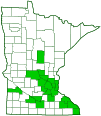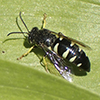four-banded stink bug hunter wasp
(Bicyrtes quadrifasciatus)
Conservation • Description • Habitat • Ecology • Distribution • Taxonomy
Conservation Status |
|
|||||||
| IUCN Red List | not listed |
|||||||
| NatureServe | not listed |
|||||||
| Minnesota | not listed |
|||||||
Description |
||
Four-banded stink bug hunter wasp is a large sand wasp. It is common in the United States and southern Canada east of the Great Plains. It is less common in Minnesota where it is at the northwestern extent of its range. Adults are ⅝″ to ¾″ (17 to 19 mm) long. The antennae on the male have 10 segments (flagellomeres) beyond the scape and pedicel. On the female there are 11 flagellomeres. The exoskeletal plate covering the first segment of the thorax (pronotum) is short and collar-like. There is a rounded lobe on each side of the pronotum that does not reach the small plate covering the wing base (tegula). The plate on the upperside of the large middle segment (mesonotum) is entirely black with no yellow markings. The abdomen of the male has seven visible segments. The abdomen is black with 4 pairs of spots on the female, 5 pairs on the male. Each pair of spots forms a band interrupted in the middle. The distance between the bands increases approaching the end of the abdomen. The spots in the last two bands are widely separated. The forewings are clear. The submarginal cell is clear, not brown. The legs are mostly yellow beyond the base (coxa). The third segment (femur) on the middle leg is not expanded at the tip. The first segment of the last part of the leg (tarsus), corresponding to the foot, is slender, not inflated. |
||
Size |
||
Total length: ⅝″ to ¾″ (17 to 19 mm) |
||
Similar Species |
||
Habitat |
||
|
||
Ecology |
||
Season |
||
June to October |
||
Behavior |
||
|
||
Life Cycle |
||
The female builds a nest in sandy soil. She provisions it with a true bug (Suborder Heteroptera), deposits an egg, then seals the chamber. |
||
Larva Food |
||
Paralyzed true bugs (Suborder Heteroptera) |
||
Adult Food |
||
Flower nectar |
||
Distribution |
||||
|
Sources |
|||
| 9/6/2023 | ||||
Occurrence |
||||
|
||||
Taxonomy |
|||
Order |
Hymenoptera (Ants, Bees, Wasps, and Sawflies) | ||
Suborder |
Apocrita (Narrow-waisted Wasps, Ants, and Bees) | ||
Infraorder |
Aculeata (ants, bees, and stinging wasps) | ||
Superfamily |
Apoidea (apoid wasps, bees, sphecoid wasps) | ||
Family |
Crabronidae (square-headed wasps, sand wasps, and allies) | ||
Subfamily |
Bembicinae | ||
| Tribe | Bembicini (sand wasps) | ||
| Subtribe | Bembicina | ||
Genus |
Bicyrtes | ||
The tribe Bembicini was formerly in the subfamily Nyssoninae. It was later (Bohart and Menke, 1976) moved to the already existing subfamily Bembicinae based on a comprehensive analysis of morphological data. |
|||
Synonyms |
|||
Bembidula quadrifasciata Bicyrtes quadrifasciata Monedula quadrifasciata Monedula sallei |
|||
Common Names |
|||
four-banded stink bug hunter wasp |
|||
Glossary
Femur
On insects and arachnids, the third, largest, most robust segment of the leg, coming immediately before the tibia. On humans, the thigh bone.
Flagellomere
A segment of the whip-like third section of an insect antenna (flagellum).
Mesonotum
The principal exoskeletal plate on the upper (dorsal) part of the middle segment of the thorax of an insect.
Pronotum
The exoskeletal plate on the upper side of the first segment of the thorax of an insect.
Scape
In plants: An erect, leafless stalk growing from the rootstock and supporting a flower or a flower cluster. In insects: The basal segment of the antenna.
Tarsus
On insects, the last two to five subdivisions of the leg, attached to the tibia; the foot. On spiders, the last segment of the leg. Plural: tarsi.
Tegula
A small, hardened, plate, scale, or flap-like structure that overlaps the base of the forewing of insects in the orders Lepidoptera, Hymenoptera, Diptera, and Homoptera. Plural: tegulae.
Visitor Photos |
|||||
Share your photo of this insect. |
|||||
| This button not working for you? Simply email us at info@MinnesotaSeasons.com. Attach one or more photos and, if you like, a caption. |
|||||
Alfredo Colon |
|||||
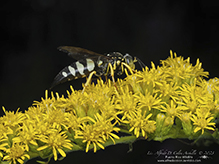 |
|||||
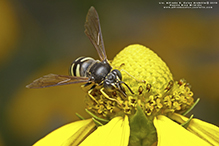 |
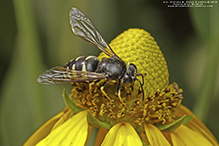 |
||||
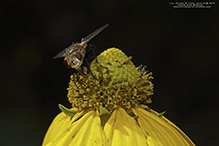 |
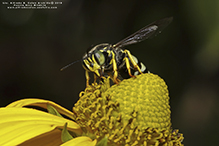 |
||||
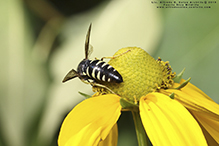 |
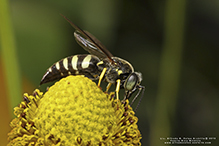 |
||||
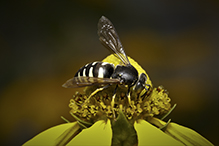 |
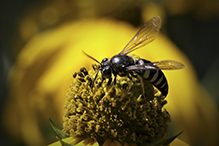 |
||||
Babette Kis |
|||||
4 banded stinkbug wasp |
|||||
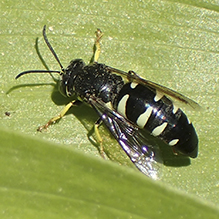 |
|||||
Maureen Burkle |
|||||
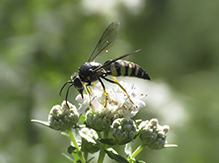 |
|||||
MinnesotaSeasons.com Photos |
|||||
|
|||||

Slideshows |
||

Visitor Videos |
|||
Share your video of this insect. |
|||
| This button not working for you? Simply email us at info@MinnesotaSeasons.com. Attach a video, a YouTube link, or a cloud storage link. |
|||
Other Videos |
|||
| Sand wasp - Bicyrtes quadrifasciatus Stoil Ivanov |
|||
About
Mar 30, 2019 Bicyrtes quadrifasciatus bringing stink bug nymph. Illinois Beach State Park, Lake County, Illinois, USA August 12, 2018 |
|||
| SAND WASP Bicyrtes quadrifasciatus Rob Curtis |
|||
About
Sep 21, 2019 Bicyrtes quadrifasciatus SAND WASP visiting flowers. Chicago Park, Chicago, IL. 8/21/2019. |
|||
| Bicyrtes quadrifasciatus Dave McShaffrey |
|||
About
Aug 17, 2013 Sand Wasps filmed at Strasburg, Ohio 8/15/2013 Video shows the wasps starting burrows and entering burrows dug previously. If you listen carefully at some points you can hear sand particles hitting the camera. In some scenes, paralyzed hemipterans (bugs) are being hauled into the burrows, where the wasp will lay an egg which will hatch into a larva to feed on the hemipteran, which remains paralyzed after being stung by the wasp. You can also see other insects entering the burrow, in particular small flies were common around the burrows and sometimes entered them. I think the flies are parasitizing either the paralyzed hempiterans or the wasp's eggs or larvae. This population has been at this site for over 10 years. |
|||


Created: 1/29/2020
Last Updated:
